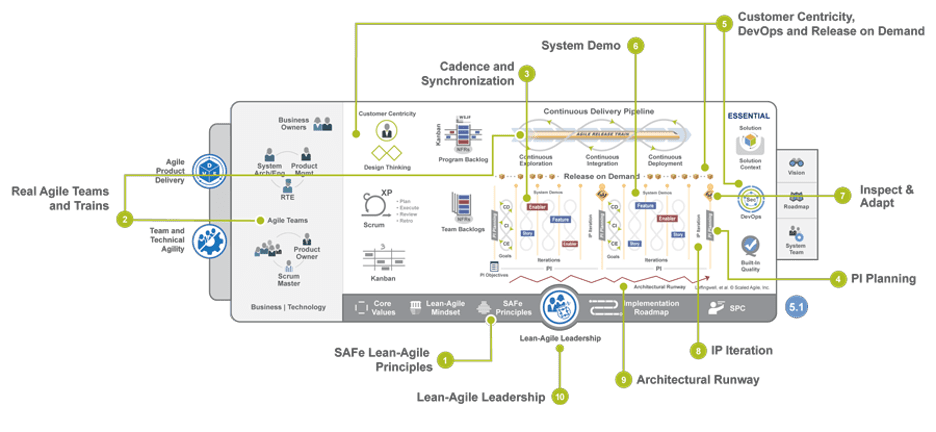Find true success with your SAFe® implementation
A big part of my personal life revolves around motorcycles, specifically road racing and coaching. When I’m working with new racers or track riders who want to improve their skills, the first thing I do is ask them to complete this sentence: “Practice makes _____.” Almost everyone says “perfect!” But usually, the opposite is true. When racers go out on the track and continue to repeat bad habits, such as not moving their eyes down-track or using poor body position, they simply cement the wrong technique, which is more difficult to correct later. I always teach riders to focus on learning the basics and build on these good techniques until they become permanent. We all start with the belief that practice makes perfect. However, if you practice the wrong things, the only thing you perfect is the wrong approach. (Note: I want to thank Nick Ienatsch from the Yamaha Champions Riding School (YCRS) for helping me see the importance of learning the right skills before starting to practice. Working with Nick and the crew at YCRS and ChampSchool taught me so much about the importance of getting the basics right.)

Switching sports metaphors, a favorite phrase from football coaches (Marv Levy may have been the first to use this) is to “learn how to do it right and then practice it until you never get it wrong.” That’s how we bake in the right techniques, and where practice makes permanent is our ally.
When implementing SAFe®, it’s common to bring in old habits from your organization’s history. It’s hard to break free of these past practices but it’s even more difficult to change them once they’ve been brought into the transformation effort. There are many common anti-patterns that organizations practice and make permanent, including:
- Multiple Program Backlogs (whether real or virtual) make it difficult for the teams or ART to focus on the most important thing to work on; this damages Lean flow due to context switching.
- Leadership believing that their job is to direct work, which is in direct opposition to SAFe Principle 8 (unlock intrinsic motivation) and SAFe Principle 9 (decentralize decision-making).
- Not using the IP iteration for its vital purpose to be a buffer for capacity and to support ongoing innovation, improvement, and synchronized planning.
- Using PI planning as a readout of assigned plans, rather than allowing the teams to use team breakouts to discover the best plan to meet business needs.
- Objectives given to the teams rather than teams creating their own objectives. When teams review the vision and roadmap and then create their own objectives, they gain engagement and alignment with business and Product Management to demonstrate they understand the value needed.
A common issue we see is organizations treating SAFe as a buffet where you can pick and choose what you implement and what you don’t. While SAFe is highly configurable and is not at all prescriptive, there are key elements that you must implement for real success. These 10 critical success factors are the basic components that you learn and practice until you never get them wrong.

This doesn’t mean that you must be perfect to start. Learning to implement SAFe correctly is just like learning to ride both fast and safe. You learn the proper techniques and continue to inspect and adapt until you get it right, then practice these techniques until they become instinctive. That’s when the speed comes. The same concept applies to your SAFe implementation—learn the 10 critical success factors and practice them until they become instinctive. You will make mistakes along the way because getting these factors right takes time and effort. But if you continue to focus on these basics, they become part of the culture and the norm for your organization. That’s when you experience the true value of a SAFe implementation.
Practice Makes Permanent Blog Series
In this blog series, I aim to share my experiences from the field in helping organizations master and apply good, basic, Lean-Agile and SAFe practices to promote successful SAFe implementation.
Upcoming topics I plan to cover include PI planning, the Program Backlog, and SAFe roles. My hope is that as part of this effort, you will be able to achieve business agility through the Lean-Agile mindset.
Read the next post in this series here.
About Dwayne Stroman

Dwayne is an Enterprise Transformation Coach and Trainer and SAFe Program Consultant Trainer (SPCT) with more than 20 years of experience. He is ultra-passionate about helping large organizations learn how to build the right products and deliver optimal value through learning and customer validation. Dwayne uses his SPCT role to help several Fortune 100 companies, as well as many growing companies in finance, retail, healthcare, and logistics, realize the benefits of a Lean-Agile mindset. Connect with Dwayne on LinkedIn.